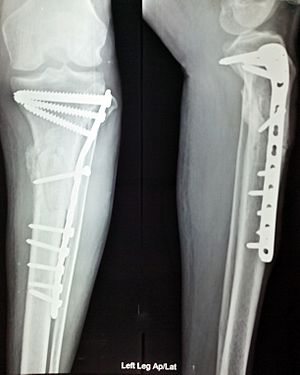Orthopedic surgery facts for kids
Quick facts for kids Orthopedics |
|
|---|---|
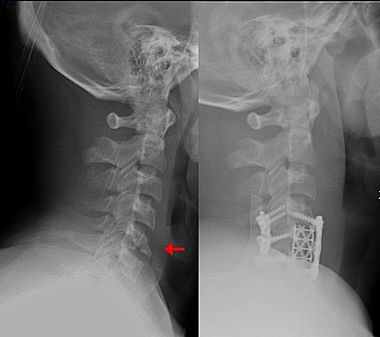
This fracture of the lower cervical vertebrae is one of the conditions treated by orthopedic surgeons and neurosurgeons.
|
|
| Specialty | {{#statements:P1995}} |
| MeSH | D019637 |
| Occupation | |
|---|---|
| Names |
|
|
Occupation type
|
Specialty |
|
Activity sectors
|
Medicine, Surgery |
| Description | |
|
Education required
|
|
|
Fields of
employment |
Hospitals, Clinics |
Orthopedics (also spelled orthopaedics) is a special type of surgery that focuses on problems with your musculoskeletal system. This system includes your bones, joints, muscles, ligaments, and tendons. Orthopedic surgeons use both surgery and other treatments to help people with injuries, diseases, and conditions that affect these body parts. This can include broken bones, spine problems, sports injuries, and even problems you are born with.
Contents
What is Orthopedics?
Orthopedics is a medical field that helps people with issues related to their bones, joints, and muscles. An orthopedic surgeon is a doctor who specializes in this area. They can treat many different problems, from a simple sprain to a complex bone disease.
Where Did the Name Come From?
The word "orthopedics" was created in French by Nicholas Andry in 1741. It comes from two old Greek words: orthos, meaning "correct" or "straight," and paidion, meaning "child."
When the word was first used, orthopedics was mainly about fixing bone and spine problems in children. Over time, it grew to include treating people of all ages for all kinds of musculoskeletal issues.
Spelling Differences
You might see "orthopedics" spelled in two ways: "orthopedics" or "orthopaedics." Both are correct! The spelling with "ae" is more common in places like the UK. In the US, both are used, but the shorter "orthopedics" is often seen in hospitals.
A Look Back: History of Orthopedics
Orthopedics has a long history, with many important discoveries. Some big steps forward happened during wars, as doctors learned new ways to treat injuries.
Early Days of Orthopedics
Long ago, in the Middle Ages, doctors used things like bandages soaked in horse blood to make stiff splints for broken bones. It sounds strange, but it helped!
In 1741, Nicolas Andry wrote the first book about orthopedics. He suggested using exercises, special movements, and splints to fix problems in children.
Later, in 1780, Jean-André Venel opened the first hospital just for treating children's bone problems. He even invented a special shoe for babies born with clubfoot, a foot deformity.
Over the years, doctors like John Hunter and Percival Pott learned more about how tendons heal and how to treat spine problems. In 1851, a Dutch military surgeon named Antonius Mathijsen invented the plaster of Paris cast, which is still used today!
For a long time, orthopedics was mostly about fixing deformities in children. But by the late 1800s, doctors started to debate if surgery should be a part of it. One of the first surgeries was cutting a tendon, like the Achilles tendon, to help with deformities.
Modern Orthopedics Begins
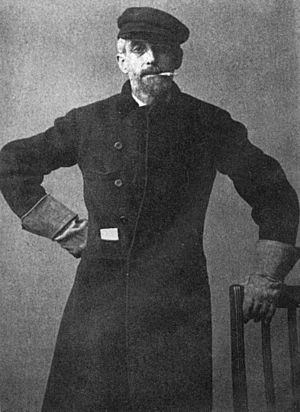
Modern orthopedics really started to take shape with people like Hugh Owen Thomas from Wales. He believed that rest was the best way to heal broken bones and tuberculosis. He invented the "Thomas splint," which helped stabilize a broken thigh bone and prevent infection. He also created many other tools and methods that still carry his name.
Thomas's ideas became very important during the First World War. His nephew, Robert Jones, also made huge contributions. He set up the world's first complete accident service for workers building the Manchester Ship Canal. During the war, he saw that soldiers' broken bones were not being treated well. He pushed for military orthopedic hospitals and made sure doctors used the Thomas splint. This splint helped reduce deaths from severe thigh bone fractures from 87% to less than 8% during the war!
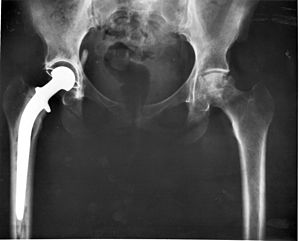
Another big step was the use of intramedullary rods (rods placed inside the bone) to fix broken thigh and shin bones. This was started by Gerhard Küntscher in Germany during World War II. These rods helped injured soldiers recover much faster.
In the 1960s, Sir John Charnley in England developed the modern total hip replacement. He found a way to replace damaged hip joints with artificial parts made of metal and plastic, glued to the bone. This invention changed the lives of many people suffering from severe joint pain. Since then, joint replacement surgeries have continued to improve.
Gavril Abramovich Ilizarov in the USSR developed external fixators in the 1950s. He used bicycle-like rings and wires to fix badly broken or infected bones. His Ilizarov apparatus is still used today to help bones heal, straighten, and even grow longer.
Today, orthopedic surgeons continue to find ways to make surgeries less invasive and to create better, more lasting artificial body parts.
Becoming an Orthopedic Surgeon

Becoming an orthopedic surgeon takes a lot of schooling and hard work. In the United States, it usually involves:
- Four years of college.
- Four years of medical school to earn a Doctor of Medicine (MD) or Doctor of Osteopathic Medicine (DO) degree.
- Five years of special training called a residency in orthopedic surgery.
Getting into an orthopedic residency program is very competitive. After residency, many surgeons choose to do even more training, called a fellowship. This extra training, usually one or two years, lets them specialize in a specific area of orthopedics.
Special Areas in Orthopedics
Orthopedic surgeons can choose to focus on many different parts of the body or types of conditions. Some common specialties include:
- Foot and ankle surgery
- Hand and upper body surgery
- Hip and knee surgery
- Orthopedic trauma (treating severe injuries)
- Pediatric orthopedics (for children)
- Shoulder and elbow surgery
- Spine surgery
- Sports medicine (treating sports injuries)
- Total joint replacement (arthroplasty)
Some of these areas, like hand surgery or spine surgery, are also practiced by other types of surgeons, like plastic surgeons or neurosurgeons.
After all this training, orthopedic surgeons must pass special exams to become "board certified." This shows they have met high standards for their education and skills.
What Orthopedic Surgeons Do
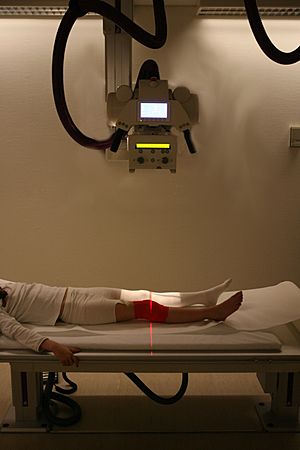
Orthopedic surgeons perform many different procedures. Some of the most common ones include:
- Knee arthroscopy (looking inside the knee with a tiny camera) and repairing cartilage.
- Shoulder arthroscopy and decompression (relieving pressure).
- Carpal tunnel release (surgery for wrist pain).
- Removing support implants (like plates or screws after a bone has healed).
- Repairing broken bones, especially in the hip, ankle, and wrist.
- Knee replacement and hip replacement surgery.
- Repairing torn tendons, like the rotator cuff in the shoulder.
- Spine surgeries, such as laminectomy or spinal fusion.
A typical week for an orthopedic surgeon is very busy. They spend time in the clinic seeing patients, performing surgeries, and handling administrative tasks. Many also teach or do research.
Arthroscopy: Tiny Cameras, Big Help
Arthroscopy is a very important technique in modern orthopedics. It was first developed in the 1950s. With arthroscopy, surgeons make tiny cuts and insert a small camera and special tools into a joint. This lets them see inside and fix problems without making a large incision.
The big advantage of arthroscopy is that patients recover much faster. Instead of weeks or months, recovery can take just a few days. Knee arthroscopy is one of the most common orthopedic surgeries today, often used to fix cartilage or ligaments. Many shoulder and other joint procedures are also done this way.
Arthroplasty: New Joints for Old
Arthroplasty is a type of orthopedic surgery where a damaged joint surface is replaced or reshaped. This is often done to relieve pain and help a joint work better, especially after damage from arthritis or an injury.
The most common arthroplasty procedures are total knee replacement and hip replacement. In these surgeries, the damaged parts of the joint are removed and replaced with artificial parts, often made of metal and plastic.
After a joint replacement, doctors pay close attention to how the new parts wear down over time. They use strong, special plastics to make the implants last as long as possible.
How Common Are Musculoskeletal Procedures?
Between 2001 and 2016, the number of musculoskeletal procedures in US hospitals increased quite a lot. Surgeries on the spine and joints are very common for most age groups. For example, spinal fusion is one of the most frequent surgeries for adults, and knee and hip replacements are common for people aged 45 and older.
See also
 In Spanish: Ortopedia para niños
In Spanish: Ortopedia para niños



